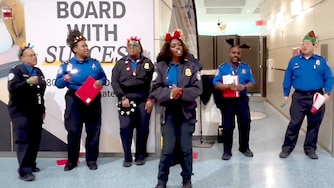As a chef with a conscience, Zack Mills has a conditional love of seafood. He loves to eat it and cook it, but his heart doesn’t always sit right with the consequences. Tuna, for instance.
“Everyone loves yellowfin tuna, but I’m not going to be cooking them in this restaurant,” Mills said, “because I want to believe whatever I’m pulling out of the water is something that I know will still be there for generations to come.”
Mills is the chef at True Chesapeake Oyster Co., a paean to the seafood traditions of the bay. His menu includes locally harvested oysters and blue crab that pass his litmus test, but the fish that his conscience has zero concern with is blue catfish, fast becoming the most prolific creature in the Chesapeake. The invasive species is suspected of reducing populations of local rockfish, crab and other native fish, and altering the balance of aquatic life in the bay.
Chef Zack’s catfish is pounded, breaded and pan-fried schnitzel style, served with potatoes, squash, mushrooms and a sauce of lemons, capers and dill.
“There’s so much of it, we should be eating as much of it as humanly possible,” he said. “The fortunate thing is it tastes good. And it’s invasive. So it hits all the bars for a fish we should be eating.”

Mills is part, albeit a small one, of the solution that is showing signs of momentum to a problem decades in the making. About 40 years after being introduced in Virginia waters as quarry for recreational fishermen, blue catfish are overrunning the bay, accounting for the majority of biomass in some rivers, according to studies.
Last year, Gov. Wes Moore asked the federal government to declare a fisheries disaster for the state so it could receive federal aid. The reason he gave was the effects of invasive species, specifically catfish and snakehead. His request was denied in January.
Despite Moore’s plea and a public call to arms by the state’s Department of Natural Resources, we’re not making a sizeable dent in the population.
In the 1980s, Virginia officials allowed the species to be released into the James River, believing catfish would not enter the bay ecosystem because they were freshwater fish. But the catfish have since proven to be more tolerant of brackish water than expected. Because of climate change, the bay is getting less salty and becoming only more hospitable to catfish.
The catfish problem is “compounding other things going on in the bay,” said Allison Colden, a marine scientist and the Maryland director of the Chesapeake Bay Foundation. “This is happening against the backdrop of water quality concern, habitat concern, and climate change.”
Without human intervention, catfish are likely on their way to becoming the dominant species of the Chesapeake — if they aren’t already.
They are “opportunistic, generalist omnivores,” said Noah Bressman, an assistant professor of physiology at Salisbury University who studies invasive species. Put another way, they “can and will eat anything around them.”
Contained in the stomachs of catfish he has found striped bass, blue crab, gizzard shad, river herring, white perch, muskrats, turtles, small birds, and even an adult wood duck. They swallow it all whole, including small rocks they hoover up from the bottom of the bay along with their food.

Catfish are native to the southern U.S. where they have some predators, like alligators. But in the Chesapeake, catfish are top dog so to speak, unless the ultimate apex predators — humans — step in.
The supply of and demand for catfish as food currently favors the fish.
On the demand side, catfish just aren’t as popular to eat as they are in the South. Because the local seafood culture is trained on oysters, crabs and rockfish, appetites are somewhat ignorant of catfish. Some aren’t aware it’s a local fish. Its reputation as being muddy tasting — this is much less true of Chesapeake catfish — doesn’t help. Mills said he has heard talk of changing the name to something like Chesapeake blue, to refresh its image, much like the state changed the name of the invasive northern snakehead fish to Chesapeake channa.
Then there’s the supply problem. Not many grocery stores carry catfish, and few restaurants serve it, save for places like True Chesapeake that have taken it on as a cause.
Supply is limited by regulations that mandate all catfish processed in the U.S. be inspected by the U.S. Department of Agriculture. Most seafood is regulated only by the Food and Drug Administration. The USDA typically oversees production of poultry, beef, and pork. Its purview of catfish is unique and was intended specifically to benefit the U.S. farmed catfish industry in the South, protecting it from foreign competition.
In 2021, state Sen. Guy Guzzone introduced a joint resolution that urged Congress to return federal oversight of Maryland catfish to the FDA. Nothing has yet come of the proposal.

Stephanie Pazzaglia, who works for a large regional distributor, said regulations are not her primary concern. She is the business development manager for J.J. McDonnell & Co., one of four certified processors of catfish in Maryland. She is more concerned about creating consumer demand for the product, what she called “volume opportunities.”
“It’s a matter of more education, and more positive messaging,” said Pazzaglia, who evangelizes the virtues of eating local catfish wherever and whenever she can. “A lot of education is needed to encourage a chef to put it on the menu.”
Mills is a convert. He described it as not too delicate and not too firm, with a relatively mild flavor that stands up to assertive seasoning and can be cooked with any method.
“It’s a really versatile fish,” Mills said, “and you can do almost anything with it.”
He pointed out that unlike southern catfish, the local blues are not bottom feeders but feed in the water column on the same seafood we eat. He described it as tasting fishier than, say, cod, but less fishy than species like mackerel or salmon.
“We wanted to be a love letter to the Chesapeake Bay,” Mills said. “Doing invasive species was a big part of that.”
Another convert is Steve Chu, the owner of the popular casual eatery Ekiben, which used to serve a catfish entree it called the “tackle box,” batter-fried catfish served over rice with pickles and slaw. Chu removed it from the menu in January because of low demand. He is convinced the price, not the taste, deterred customers. Chu had to charge more than $20 for it to make ends meet, and customers weren’t willing to pay it.
“The catfish was one of my favorite things and a lot of our customers said it was their favorite,” Chu said, “but it was cost prohibitive to a lot of our guests.”
In theory, catfish ought to be among the most affordable seafood in the bay. They form schools and can be caught in nets. They are plentiful. And they live in our backyard. Millls said he pays about $10 a pound for filleted catfish from his distributor.
Bressman, the scientist, has come up with a direct-to-consumer strategy for consuming catfish, organizing a yearly catfish tournament in the Nanticoke River in Sharptown. His motives are partly selfish. The tournament catch has yielded useful scientific data. The meat gets eaten, although for the purposes of restoring a natural balance, the catfish don’t need to be eaten, just killed.
Last year’s tournament brought in more than 1,000 pounds of catfish. Organizers don’t charge an entry fee to encourage participation. Prize money is offered. For newcomers to fishing and to catfish, lessons are offered in catching, filleting the fish, and even cooking it, complete with recipes for catfish cakes and catfish stew.
“When people tell me they don’t want to eat it because they’re muddy bottom feeders, my response is don’t eat crabs if you don’t like muddy bottom feeders,” Bressman said. “It’s up to us to catch them. We’re the ones who put them here.”




Comments
Welcome to The Banner's subscriber-only commenting community. Please review our community guidelines.